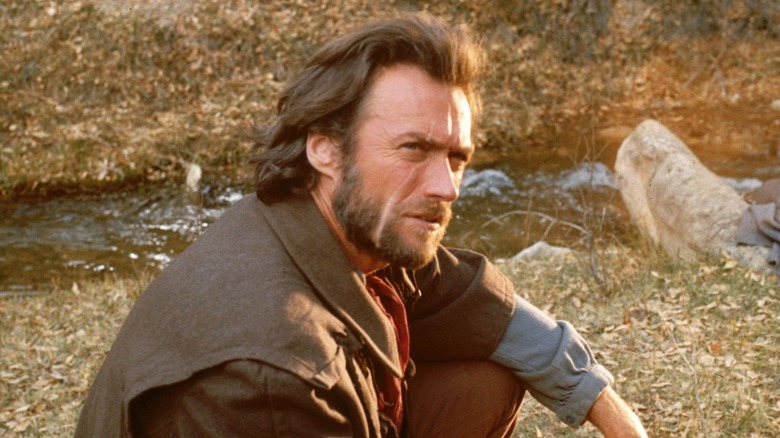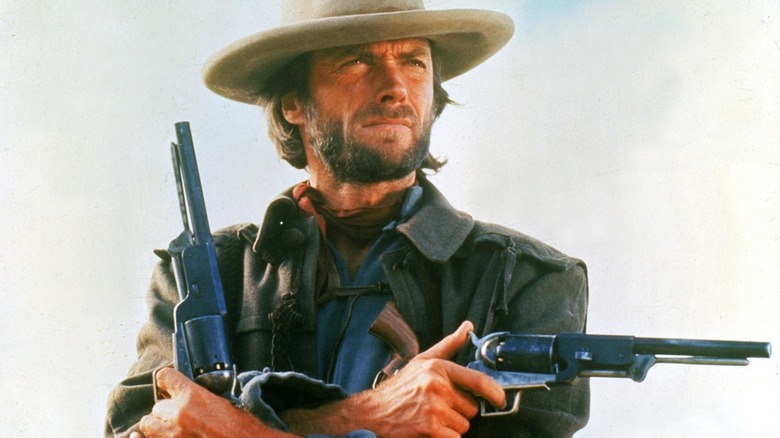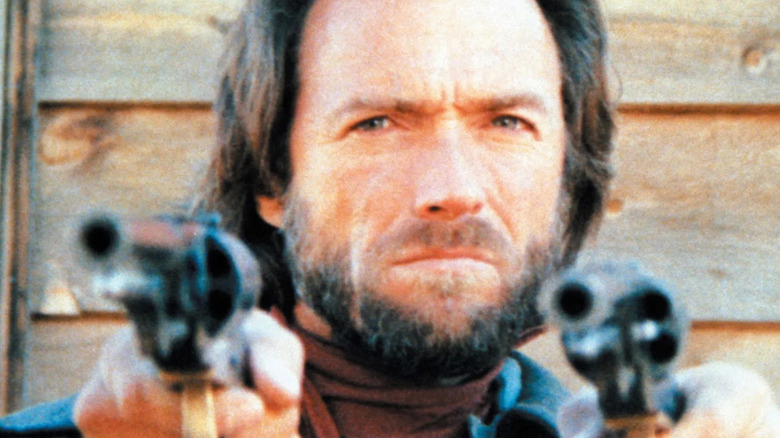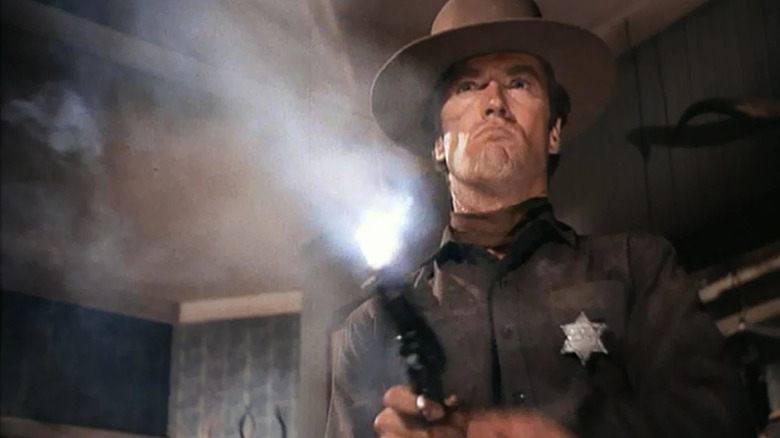Clint Eastwood Copied A Secret Service Trick To Keep His Crew Calm On Set
Clint Eastwood's first film as a director was "Play Misty for Me" in 1971, in which he also starred. Eastwood would direct 12 additional features in which he also played the lead prior to "Bird" in 1988, his first film as a director in which he did not appear. "Bird," as this writer recalls, represented a shift in Eastwood's career. He was no longer the star and director of "tough guy" thrillers and Westerns, but a more thoughtful, soulful director. At age 58, Eastwood seemed to have entered a "mellowing out" phase, more interested in deconstructing his prior career as a tough guy. When he wasn't tearing down his image in films like "White Hunter, Black Heart" and "Unforgiven," he was leaning into calmer, sometimes downright gentle films like "The Bridges of Madison County" or "Midnight in the Garden of Good and Evil."
Now in his early 90s, Eastwood has directed 40 feature films, an output so prolific he would be a notable presence in Hollywood even if he had never acted.
As a director, Eastwood is on record with how quiet and relaxed he likes to keep his sets. He does not advocate shouting, and as he explained in a 2006 interview with DGA Quarterly, he loathes background chatter. 2006, incidentally, was the year Eastwood released two interconnected films called "Flags of Our Fathers" and "Letters from Iwo Jima." Both films tell the story of the 1945 Battle of Iwo Jima, with the first from the perspective of the American soldiers, and the second from the perspective of the Japanese.
To keep things quiet on the set, as Eastwood learned many years prior, conversations needed to be kept quiet. Luckily, a contact in the U.S. Secret Service provided him with a solution: Secret Service headsets.
'I like to have fun'
Although Eastwood often plays stern or stoic figures — or even sad, tragic ones — he likes to keep the mood on his sets light and relaxed. Tension, he seems to feel, is antithetical to directing; you will hear no William Friedkin-like stories of Eastwood playing loud music and firing guns on set just to keep people on edge. More than anything, Eastwood has a pet peeve of crew members having to shush one another just as cameras are rolling. In the DGA interview, Eastwood explained it like he was an elementary schoolteacher:
"I like to have fun. I like everyone to be in good humor. And I try to keep it quiet. I like an atmosphere that isn't loaded with tension. I don't like sets where people are yelling at each other. The thing I dislike the most is people going 'Sssh sssh sssh,' because they end up making more noise than the people they're trying to shush. I remember after I started directing I was on a picture over at MGM, I walked out on the soundstage and all of a sudden I hear this huge bell ringing, which meant they were going to start the scene, and I thought, 'What is this s***?'"
Buzzers and bells are common on certain film sets, but for actors and crew people who require a certain amount of concentration, they can be antithetical to filmmaking. Eastwood, it seems, likes to keep his film sets feeling akin to live theater. A quiet set, actors on a stage, the crew keeping quiet so a live audience doesn't hear. He's a very natural, instinctual director who simply puts the camera down, gets everyone quiet, and shoots. He is not one to rely on technical fineries.
Party in the CIA
Eastwood explained that his quiet sets are good for actors. He claimed that a quiet set meant his actors had the ability to start and stop a scene without making a big production of it, saying that Tim Robbins and Sean Penn — the stars of his 2003 film "Mystic River" — appreciated it. Robbins and Penn are veterans of their craft and liked that they could approach a scene from a laidback standpoint. But Eastwood believes that this approach takes the edge off for neophyte actors as well, as the spotlight is now (metaphorically) off them.
Eastwood struck upon a solution many years prior when he was visiting Gerald Ford at the White House(!). When he saw Secret Service agents having quiet conversations off in shadowy corners, all to ensure that the President and his retinue could more cleanly converse, Eastwood made the connection to filmmaking. He said:
"I went to the White House for a dinner ... and I noticed that there were these Secret Service guys all around and they were all talking very quietly into these tiny headsets, carrying on entire conversations without disturbing anyone. So I came back here and I said, 'Why the hell do you go on a movie set and people have open radios squawking and people yelling, 'Hey, Al, put the light over here!' We've got all this technology; certainly we can be as technologically sound as the Secret Service.'"
Headsets seem like such a simple solution, it's astonishing they weren't already a Hollywood common practice. Eastwood began using the headsets, and found concurrent work could be done, everything was smooth, and, most importantly, everything was quiet.
Silence!
Eastwood didn't want just any old headsets. He wanted the exact kind that was being used in the Ford White House. He brought them to his next movie — by the timeline of events, it was most likely "The Outlaw Josey Wales" from 1975 — and everything began to work the way he wanted. He knew immediately this was the way going forward, for veterans and for the times he had to work with kids.
Eastwood has worked with child actors in "A Perfect World" and "Cry Macho" and several other pictures in between. He spoke about how he hired someone to, perhaps poetically, gather intel on the Secret Service.
"So a guy who was working for me researched it, got the same headsets and then all of those conversations could take place without disturbing the whole set. You can be rehearsing the actors and the crew can be talking, but nobody's hearing it. Sometimes you're working with kids or people you don't want to be conscious of the camera. This way you can roll the camera without them even knowing it, and you can get natural moments you wouldn't get when someone's screaming, 'Silence! Rolling! Action!'"
Eastwood is more prolific at 92 than filmmakers half his age, and his films tend to be moody and thoughtful. Fans can take note that a simple thing like a headset can go a long way to improving a director's job and the films they make.



